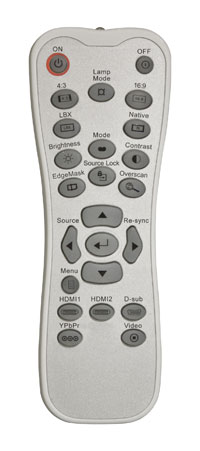Optoma HD20 DLP Projector Page 2
Setup
Due to the HD20's placement limitations, the largest image size I could manage at our studio was 65 inches wide. As a result, the black level was fairly high—the larger the projected image, the lower the black and peak-white levels. Speaking of peak-white level, it was higher than ideal in this case, so a larger image would help at both ends of the brightness range.
 After setting the basic picture controls, real-world content looked washed out; adjusting the gamma controls helped, but then test patterns looked worse. Of course, when in doubt, favor real-world content over test patterns!
After setting the basic picture controls, real-world content looked washed out; adjusting the gamma controls helped, but then test patterns looked worse. Of course, when in doubt, favor real-world content over test patterns!
The Sharpness control seemed to have no effect on Blu-ray player but a big effect on images from the test-pattern generator. Again, real-world material is far more important than test patterns, so I set this control to its minimum value.
The Cinema and Reference picture modes measured closest to the established video standards, and they looked and measured about the same. The color of gray was a bit blue, but not bad. Full calibration got things very close to correct; see "HT labs Measures" for more.
Interestingly, the component-video input looked considerably worse than HDMI; Contrast and Brightness were difficult to set correctly, and the Sharpness setting was either very soft or overly enhanced.
Performance
All dark scenes and shots in outer space looked pretty bad on the HD20—black was dark gray, which also made letterbox bars on movies plainly obvious. Also, shadow detail was not good in dark scenes, such as the night scenes in Star Trek (Blu-ray), with lots of large, solid blobs of dark gray. On the other hand, bright scenes looked great—for example, the over-the-top colors in Speed Racer (Blu-ray) were eye-popping, and the bright desert scenes in Hidalgo (Blu-ray) were beautiful with excellent skin tones and desert browns.
The overall detail was sharp and clear in things like the stone buildings in Hidalgo and the cityscape in Speed Racer. However, when I played Moulin Rouge on DVD via component video at 480i, the image was very soft, and the normally riotous colors were quite muted. Upscaling the DVD in the player and sending the signal to the projector via HDMI was much better, with sharper detail and more vivid colors.

- Log in or register to post comments





























































